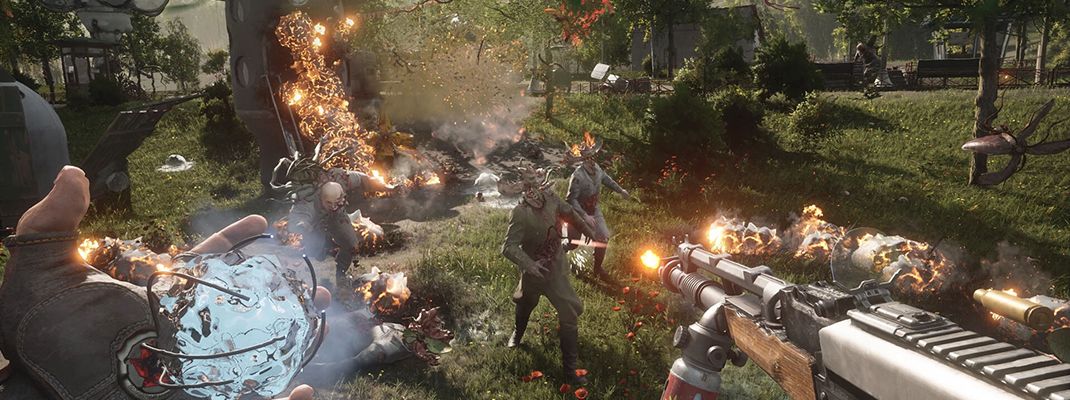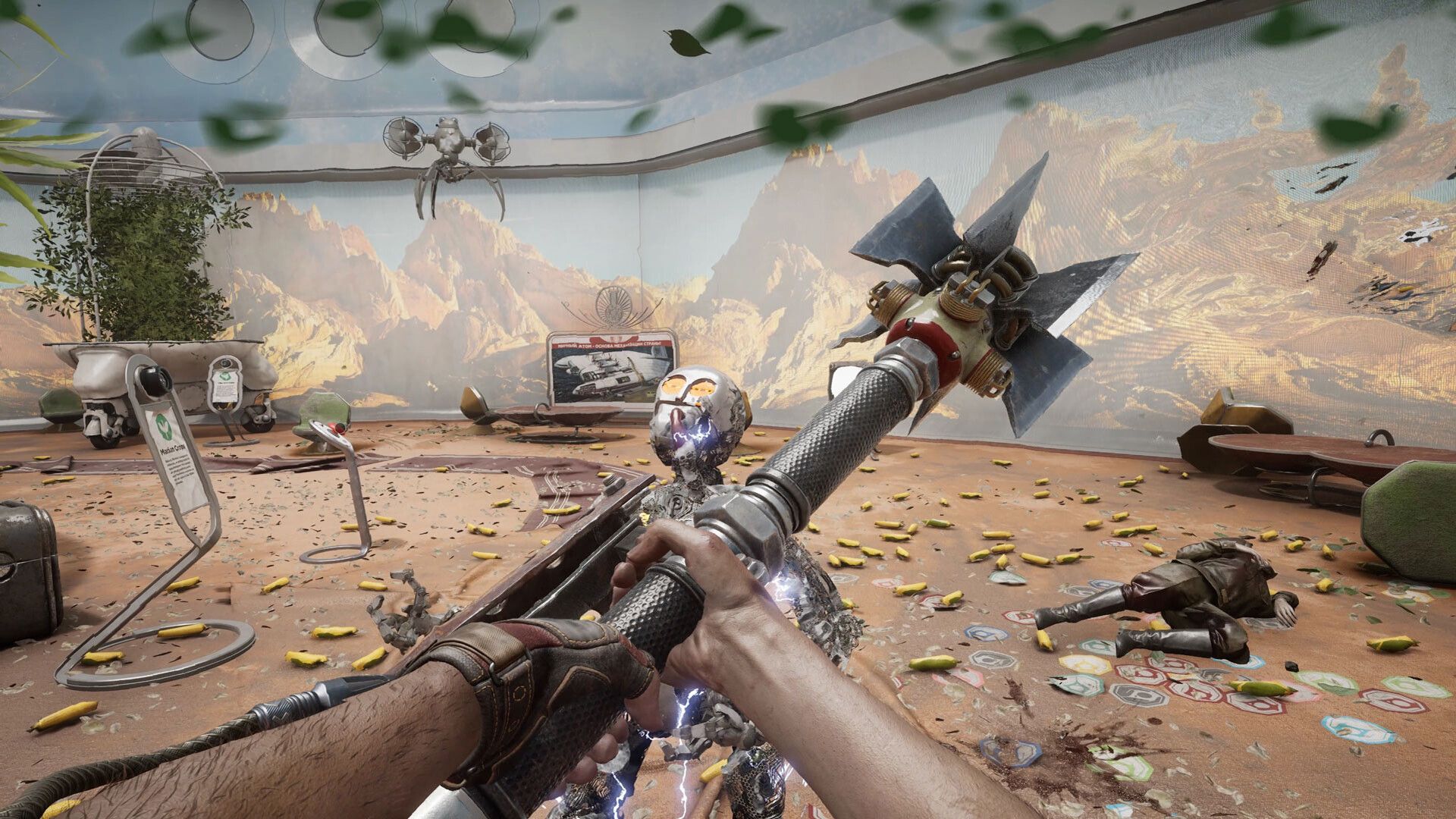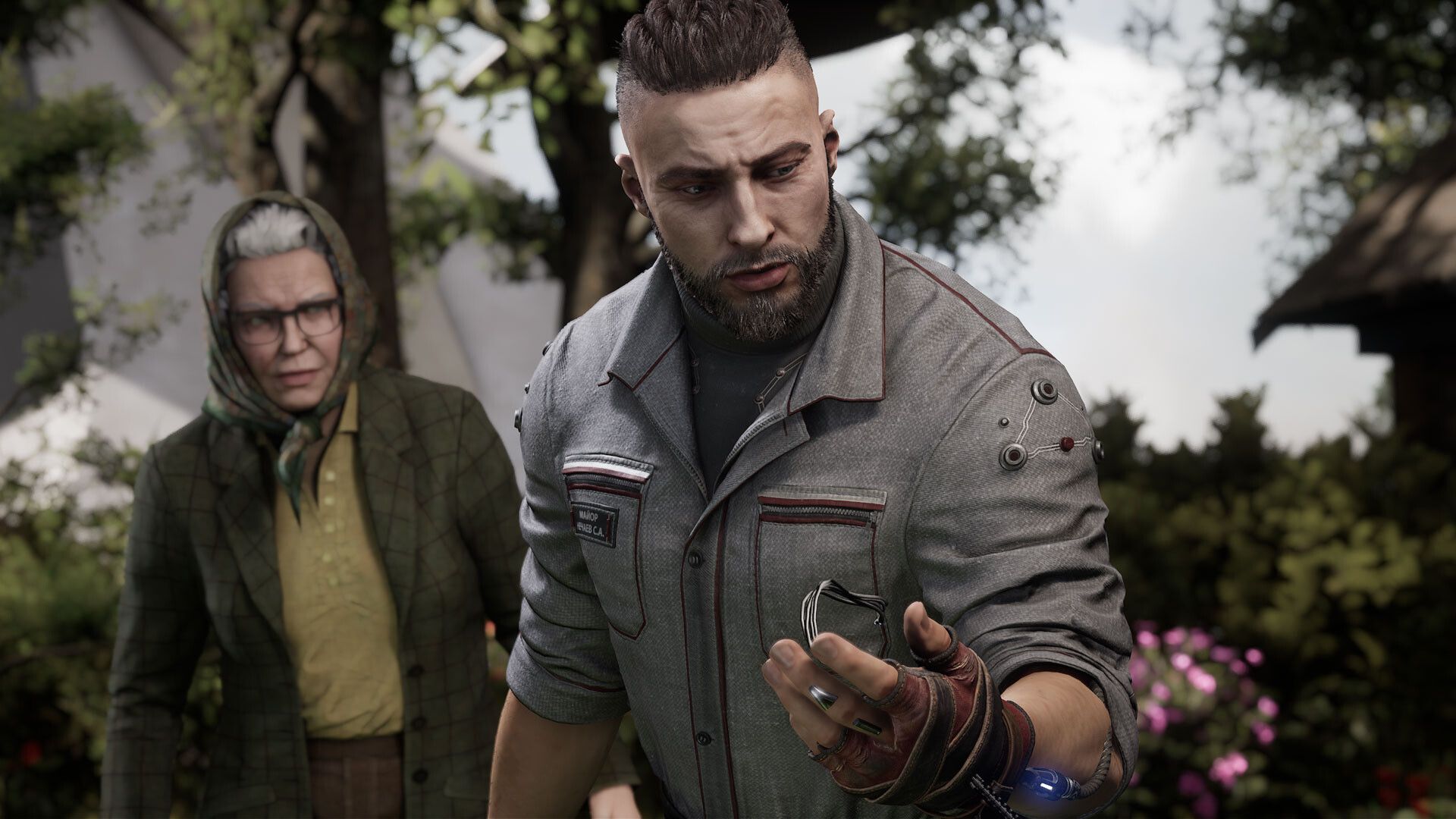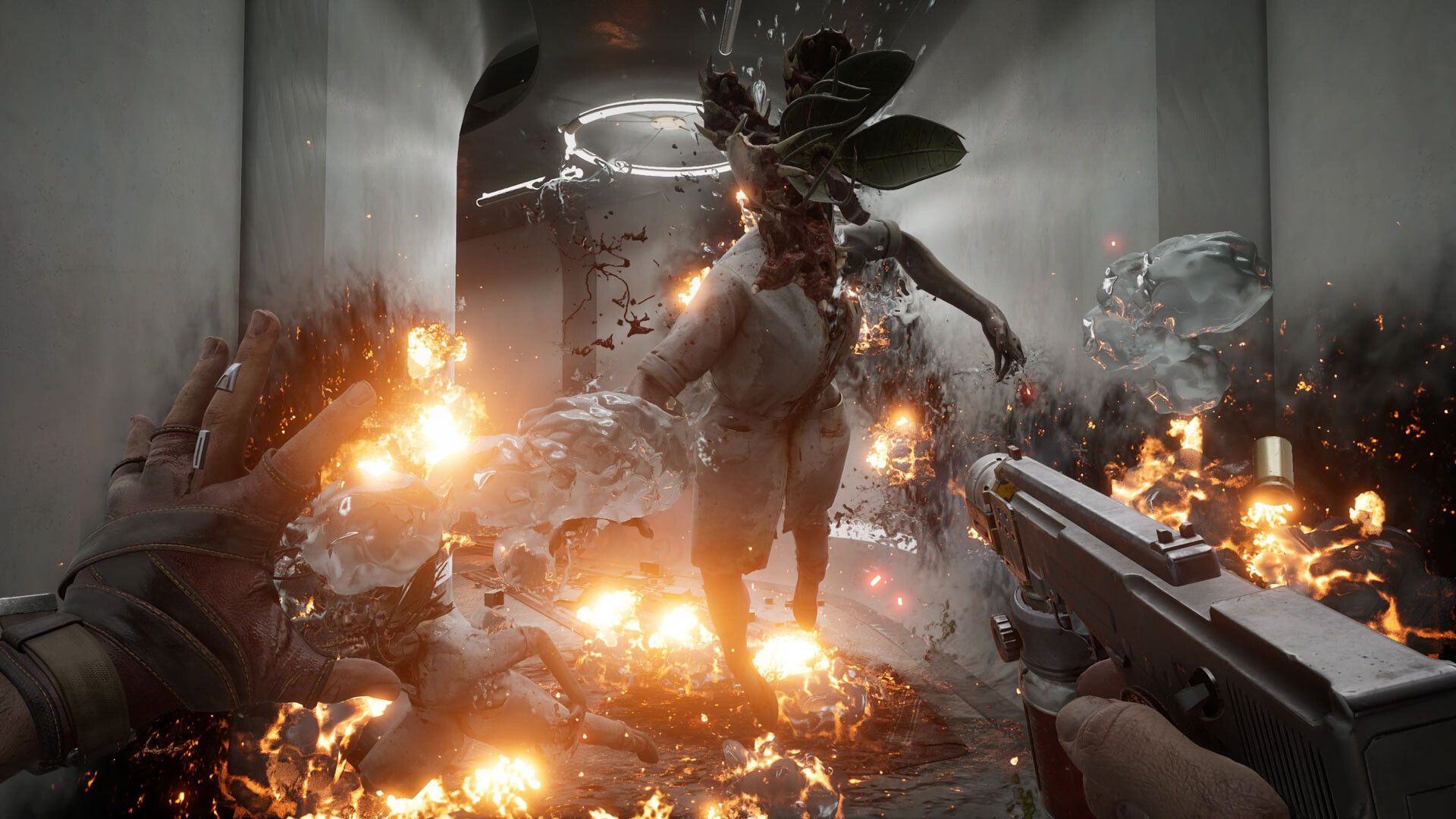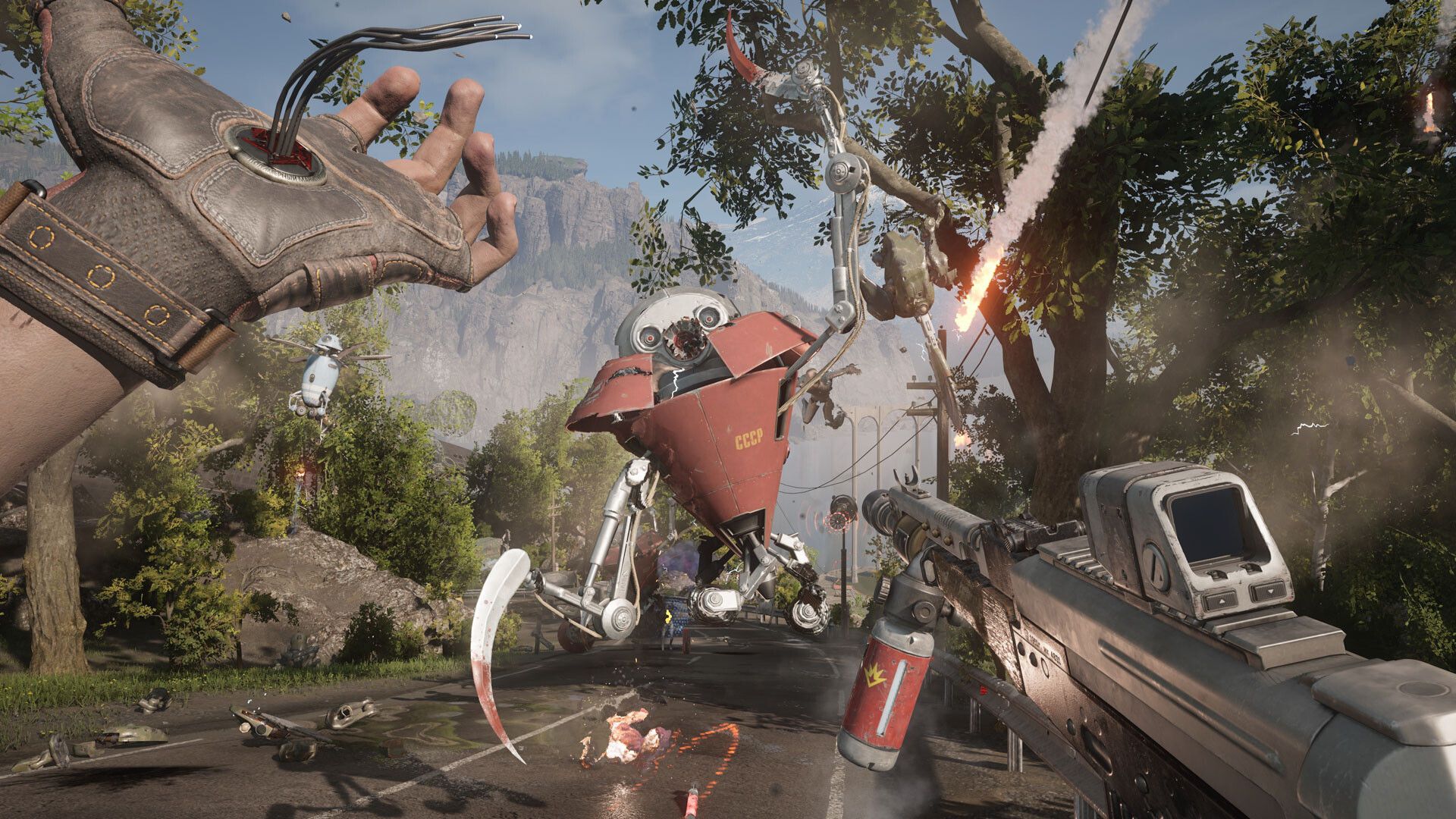There's something about the 1950s that seems to make a country go all romantic. It's probably got something to do with recovering from World War II, but whatever the reason may be, the style of the time was amazing. Cars had fins, chrome was everywhere, the space race was starting, and so long as you lucked into being part of the right social group, the future seemed filled with boundless possibilities. If the US can wallow in this kind of rose-tinted nostalgia, it seems only fair that other countries get to as well, and Atomic Heart is set in a Utopian alternate history of 1950s Russia.
It's a beautiful day in the Russia of 1955. The sun is shining and the townspeople are celebrating the next great scientific advancement from the brilliant mind of Doctor Sechenov. His Kollectiv network has seen robots go from clunky, industrial designs to a networked group of uncanny-valley humanoid mechs, and the day for the announcement of Kollectiv 2.0 is finally at hand. Now humans will be able to join the robots' neural network, with all minds united and learning becoming as simple as integrating the information, "I know kung-fu"-style. Russia leads the world in technological advances thanks to Sechenov's advances in the field of robotics, and Kollectiv 2.0 will cement its position as the powerhouse nation to lead humanity into its shining future. The robots have already gifted the country with cities floating through the air and majestic statuary tall as mountains, and with human thought integrated into the Kollectiv network, the the sky is no longer the limit.
Meanwhile, Agent P-3 and his talking AI glove Charles (pronounced Char-less) are taking a nice boat ride through town on the way to a mission briefing. While Atomic Heart is an action-packed FPS adventure, it starts slow and lets the world-building take place before throwing you into the middle of things. There's a fair amount to learn before diving in, and the intro lets you walk through Agent P-3's world at your own pace to pick up as much or as little as you feel necessary. The town is gorgeous and inviting, however, so it's easy to lose time chatting with a neuro-headset vendor (they're free to all citizens), watching an early-model robot juggle, or listening to an old soldier pay his respects to lost comrades at an eternal flame. Even with all this to explore there's work to be done, and the Major soon arrives at his first destination to get Charles fitted with a cyber-upgrade that allows him to scan the area for people, items and other points of interest.
And then, of course, everything quickly goes wrong. After hopping into a car to be flown from the flying city back to solid ground the robots attack, having been sabotaged to view all humans as threats. The Major ends up deep in an underground laboratory that's just one section of Facility 3826, and the robots have done a number on the place. The Major's mission is now to capture the saboteur alive and exit the compound, and of course it's not going to be anything like that simple seeing as he's only armed with an axe at the start. The trick to survival, though, is to take it one step at a time while upgrading the arsenal and learning all the new skills a cyber-glove can offer.
While it doesn't take long for the axe to be joined by a shotgun, it's actually a strong weapon to start with once you get used to using it. The robots overruning the facility, with their white bodies and creepy plastic faces, can be a real threat, but Atomic Heart is generous with the healing and it doesn't take long to get the feel for the flow of combat. Enemies have standard attacks and power moves, the latter of which get telegraphed with a red ring around the enemy, and those are easily avoided with a tap of the shift key for a short dash out of the way. A little strafing, dashing and charging up the axe's secondary power strike takes care of the attacker, which can then be scavenged for parts.
Scavenging is a major mechanic in Atomic Heart, and the resources are used to craft and upgrade weapons as well as purchase new skills for Charles. There are a lot of places to get items from, including desks, cabinets, boxes, chests, defeated enemies, filing cabinets and sometimes just laying on the ground, and this would get very old, very fast if it wasn't for the glove having what amounts to a vacuum cleaner function. Holding down the all-purpose action button sets Charles to Hoover-mode, so rather than needing to open up each interactive object individually, you can just scan the lot and rake in the loot. It all gets automatically dumped into inventory or, if inventory is full, sent to storage for later use, and most save rooms come with an insane-AI vending machine that can process the scrap into all sorts of useful items.
The two main categories are for weapons and abilities, each of which runs off its own set of collectibles. While this sounds like it could be a bit much, a Nintendo 64-style collectathon in a retro-cyberpunk FPS, in actuality it's much simpler than that -- the scan ability lets you know where things are in the level, and you get to either pick up the obvious loot while puzzling out how to get some of the more obscurely-placed items, or just grab and go while tearing through each new encounter. A good number of the more fun weapons need scarce materials, though, so it's best to keep an eye out and explore the many areas at least a little to get quick access to the pistol, machine gun, various types of melee weapons, and the upgrade paths to improve handling, damage and even elemental effects.
While weapons are nice, they're not the only tools in the Major's skill-set. Charles' upgrades add a good number of more tactical options, such as a stunning electro-zap, freezing cryo-mist, polymer-goo that's susceptible to elemental effects, and even telekinesis for when you just want to lift up a crowd and slam them into the ground. The skills are all designed to work together as well, such as the way telekinesis leaves a good window open to spray everyone with polymer before sinking a few fire-element bullets into them. There are a lot of options for creativity in combat, and by the time that first lab is complete, you should have a nice selection to play with.
That first simple mission gets complicated quickly, and the huge area of the laboratory turns out to be just one of Facility 3826's bunkers, labs and other places to fight and/or puzzle through on the way to learning what Doctor Sechenov's Project Atomic Heart actually is. The bunkers are all connected by a decently-sized overworld, covered with points of interest and plenty of areas to explore between one level and the next. Atomic Heart can be a long game if you're the kind of player who looks for everything (I took nine hours to get out of that first lab) and the switch-up between a focused level and open world feels like just the refresher it needs. Plus you can hop in a car and blast through enemy checkpoints, sending robots flying everywhere, and that alone is all the reason necessary for the open world section to exist. It also has the advantage of showing off yet more of the incredible design-work that went into Atomic Heart's world.
While the game is a lot of fun, combining solid action broken up by plenty of exploration and more than a few puzzles, the eye-candy along the way is truly fantastic and it can't be overstated how important the visual design is to the whole experience. Everything from incidental machinery like the save points or buttons that activate a voice-over explaining a background detail like a display at a museum, to the many types of flying, rolling or walking robots, to the rooms where major set-pieces occur are all visual treats that deserve taking a moment to appreciate. It's hard to take a moment to visually dissect a robot trying to insert a saw blade into your face, appreciating the 1950s-style curves of its frame and the way the bits of machinery seem to make sense, but also hard to resist until you've seen enough to get used to them. And then Atomic Heart introduces a new area, enemy or background device and it's time to look again at the fusion of deco and a touch of intentional jankiness that makes this world run.
Closing Comments:
Atomic Heart is an "everything and the kitchen sink" type of adventure that feels like it should explode from the weight of its ambitions, yet keeps it together through a combination of good pacing of new elements and a deeply likeable world. The Major actually comes across as a decent person, upset at hearing about people dying and loyal to those who have helped him, and Granny Zina owns any scene she shows up in. The Utopian retro-future turns out to have its secrets, of course, and a giant gap in the Major's memory is a flashing neon sign for narrative shenanigans, but that's OK because we came here for a roller-coaster ride after all. Atomic Heart keeps on going and throws everything at the wall, from large set-pieces to quiet moments of exploration, packed encounters or tough single enemies, stealth areas that you can bull on through if sneaking isn't your thing, and plenty of little puzzles to add more variety to a game that already had plenty. Whatever lies at the heart of Facility 3826, whatever the project ends up meaning, Atomic Heart is an incredible adventure into the retro-future history of a Russia that never existed.
Atomic Heart
Reviewed on PC
- Platform(s)
- PC , PS4 , PS5 , Xbox One , Xbox Series X , Xbox Series S
- Released
- February 21, 2023
- Developer(s)
- Mundfish
- Publisher(s)
- Mundfish , Focus Entertainment
- Genre(s)
- Action RPG , FPS
- How Long To Beat
- 16 Hours

